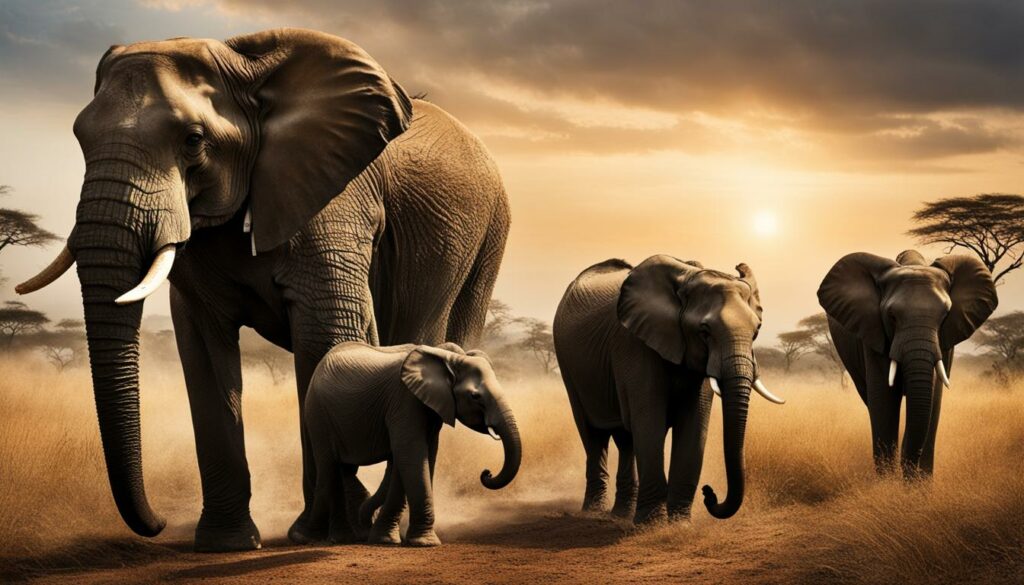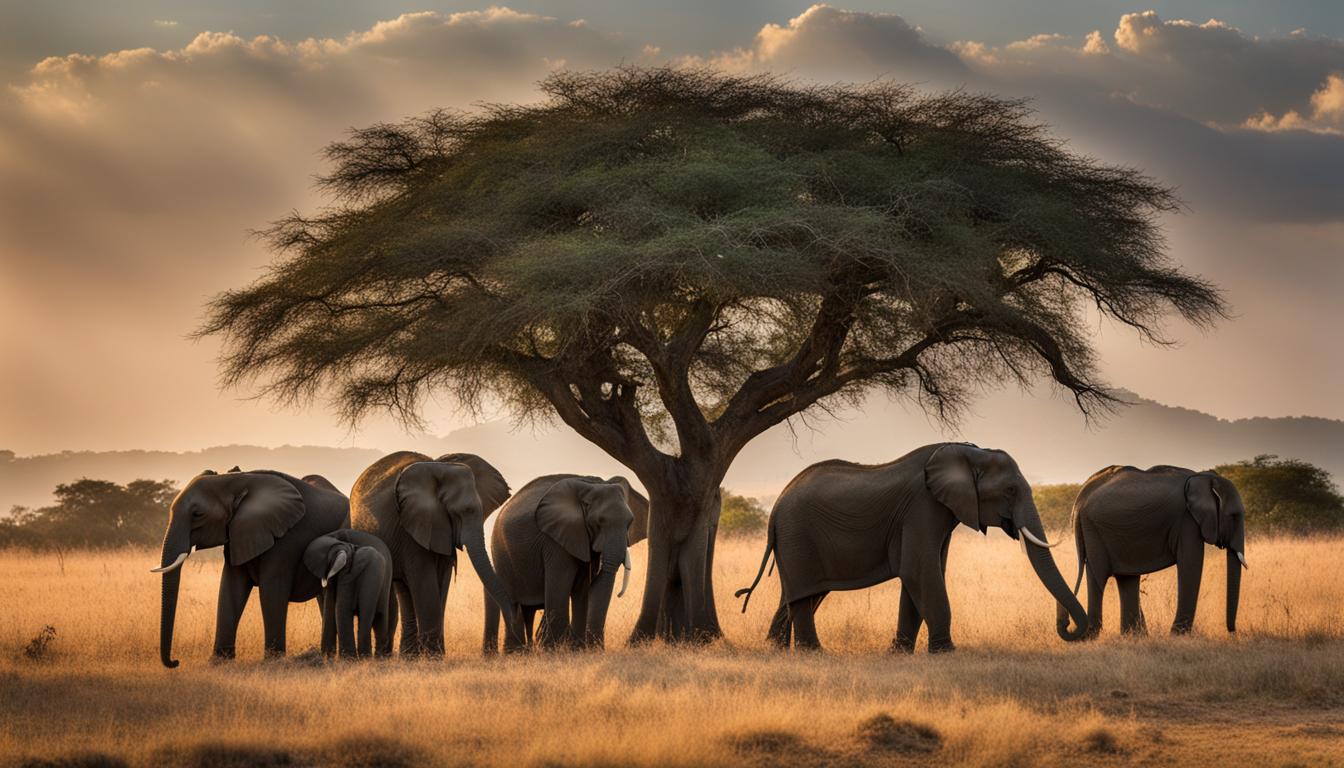Elephants have a fascinating social structure that revolves around their families. In this article, we will explore the elephant family structure, the social hierarchy of elephants, and the matriarchal elephant society.
Elephants form tight-knit herds led by a matriarch, a female elephant who plays a vital role in the overall development, protection, and well-being of the group. The basic family unit in a herd consists of the matriarch, her calves, and grand calves. Female elephants usually stay with their herds for life, while male elephants become independent and form separate herds.
The social structure of elephant herds is matriarchal, with the oldest and most dominant female leading the group. Female elephants cooperate in taking care of calves, and allomothers within the herd ensure that every young elephant is raised with love and support.
Join us as we delve deeper into the elephant family dynamics, male and female elephant roles, unique aspects of elephant herd structure, and gain a better understanding of these incredible animals’ social behavior and structure.
Elephant Family Dynamics
Elephants, as highly social animals, exhibit fascinating dynamics within their family units. The familial relationships among elephants are characterized by cooperation, support, and a strong bond between the matriarch and her family members. The matriarch, often the oldest and most dominant female in the herd, plays a vital role in guiding and protecting her family, ensuring their overall development and well-being.
Young elephants remain dependent on their mothers and other family members for several years, learning essential skills and behaviors for survival and social interaction. The matriarch serves as a source of knowledge and wisdom, passing down valuable information to the younger generations. The relationship between the matriarch and her family members is built on trust and mutual respect.
“The bond between elephants within a family is incredibly strong. They communicate through a variety of vocalizations, body language, and tactile interactions,” explains Dr. Jane Wilson, a renowned elephant behavior expert. “This communication and cooperation are crucial for the social cohesion and overall success of the family.”
In addition to their immediate family unit, elephants also form bond groups consisting of related individuals from different family units. These bond groups interact frequently, providing support to one another and strengthening the social fabric of the overall elephant community. Furthermore, elephants may come together to form larger aggregations known as clans, which include multiple bond groups and families. These clans serve as a source of social connection and security for the elephants, fostering a sense of belonging and kinship.
Elephant Family Dynamics Table
| Matriarch | Female Family Members | Bond Groups | Clans | |
|---|---|---|---|---|
| Role | Leader, provider of guidance and protection | Cooperation in raising calves, support network | Interaction and support among related individuals | Form larger social aggregations |
| Importance | Vital for family cohesion and survival | Elevate well-being and social skills development | Strengthen overall community ties | Provide a sense of belonging and kinship |
Understanding elephant family dynamics sheds light on the intricacies of their social behavior and the importance of familial relationships. These relationships contribute to the overall success, resilience, and well-being of elephant herds, highlighting the deep emotional connections that exist within this magnificent species.
Male and Female Elephant Roles
Male and female elephants play distinct roles within the social hierarchy of elephant herds. Adult male elephants are typically solitary creatures, often forming small, unstable groups with other bulls. Between the ages of 12 and 15, young male elephants leave their family units and either establish their own independent herds or join loosely-knit male groups. Their main focus shifts towards mating and reproductive activities, as they strive to pass on their genes to future generations.
In contrast, female elephants hold vital roles in the social structure of elephant herds. They form the foundation of these herds and contribute significantly to their cohesion and stability. Female elephants stay with their family units for life, providing the continuity and stability needed for the herd to thrive. The oldest and most dominant female, known as the matriarch, leads the family and makes important decisions for the group, guiding them to reliable food sources and waterholes, ensuring their survival.
The matriarch’s leadership is not limited to decision-making. She plays a critical role in raising the young calves and ensuring their well-being. Female elephants cooperate in the care of the calves, taking turns to provide protection and guidance. These allomothers within the herd are instrumental in the upbringing of young elephants, ensuring they receive love, support, and valuable life skills. Female elephants are essential for the survival of the next generation of elephants, passing down knowledge and wisdom from one generation to the next.
Female Elephant Roles
Female elephants hold several key roles in the social hierarchy of elephant herds:
- Matriarch: The oldest and most dominant female leads the family unit, making important decisions and guiding the herd.
- Protector and Caregiver: Female elephants provide protection and guidance to the young calves, ensuring their well-being.
- Allomothers: Within the herd, female elephants take turns in caring for and raising the calves, providing them with love, support, and valuable life skills.
- Knowledge Keepers: Female elephants pass down knowledge and wisdom from one generation to the next, ensuring the survival and success of the herd.
Male Elephant Roles
Male elephants also have distinct roles within the social structure of elephant herds:
- Solitary Bulls: Adult male elephants are often solitary and form small, unstable groups with other bulls for short periods of time.
- Reproductive Pursuit: Male elephants focus on mating and reproductive activities, striving to pass on their genes to future generations.
- Independent Herds or Male Groups: Young male elephants leave their family units between the ages of 12 and 15 to establish their own independent herds or join loosely-knit groups of male elephants.
The distinct roles of male and female elephants within the social hierarchy highlight the importance of females in maintaining the stability and continuity of elephant herds. The matriarch, as the leader of the family unit, plays a critical role in guiding the herd and ensuring the survival and success of future generations.
| Female Elephant Roles | Male Elephant Roles |
|---|---|
| Matriarch | Solitary Bulls |
| Protector and Caregiver | Reproductive Pursuit |
| Allomothers | Independent Herds or Male Groups |
| Knowledge Keepers |
Unique Aspects of Elephant Herd Structure
Elephants, known for their complex social structures, exhibit unique aspects in their herd compositions. While most elephant herds follow a matriarchal system led by the oldest and most dominant female, there are cases where herds deviate from this norm, showcasing their adaptability and resilience.
One such example is the Jabulani herd, which has formed its own social structure. In this herd, female and male elephants live together harmoniously, creating a dynamic not commonly observed in other herds. The Jabulani elephants have developed strong bonds with one another, demonstrating behaviors that defy traditional family units.
This unique social structure is a result of the elephants’ shared traumatic experiences and the bonds they have formed through their rescue and rehabilitation. While the Jabulani herd may not be linked by blood, their connection goes beyond genetic relationships. They have forged a new kind of family group, where individuals provide support and care for each other, regardless of their gender.
Unique Aspects of Elephant Herd Structure
| Aspect | Description |
|---|---|
| Jabulani Herd | A herd where male and female elephants live together harmoniously |
| Shared Traumatic Experiences | Elephants in the Jabulani herd have experienced traumatic events together, fostering a strong bond among them |
| Beyond Genetic Relationships | The Jabulani elephants prioritize support and care for each other, forming a new kind of family group |
The unique aspects of the Jabulani herd highlight the complexity of elephant social structures and challenge traditional notions of herd composition. It showcases the adaptability and resilience of these magnificent creatures, as they can form new family units based on shared experiences and supportive relationships.

Understanding these unique aspects of elephant herds contributes to expanding our knowledge of their social behavior and the importance of familial relationships in their well-being. It reminds us that family extends beyond genetic ties and encompasses the bonds formed through shared experiences and support.
Conclusion
The social structure of elephants is a captivating phenomenon, revealing the intricate dynamics of their herds. Led by wise matriarchs, these majestic creatures form tightly connected family units that revolve around care, protection, and support. Female elephants, dedicated mothers and allomothers, play a crucial role in raising and nurturing the young calves, showcasing remarkable cooperative behaviors.
Male elephants, on the other hand, embark on a more solitary journey, forming small, unstable groups focused on reproductive activities. While their roles differ, both males and females contribute to the stability and cohesion of the social structure.
Elephant families go beyond blood ties, extending their bonds through the formation of bond groups and larger aggregations called clans. These interactions foster a sense of community and provide mutual support. Through their unique personalities and contributions, each elephant within a herd plays a vital role in shaping the overall dynamics of the social structure.
Studying the social structure of elephants not only sheds light on their behavior and communication but also emphasizes the significance of familial relationships for their well-being. Understanding and appreciating these fascinating creatures’ social behavior and structure deepens our connection to the natural world they inhabit.
Do orphaned elephant calves receive support and care from other elephants in their rehabilitation process?
Orphaned elephant calves receive crucial support and care from other elephants during their rehabilitation process. This assistance is vital for their physical and emotional wellbeing. The presence of experienced elephants helps the orphaned calves learn essential survival skills and social behaviors, providing them with a nurturing environment to thrive. The concept of caring for orphaned elephant calves highlights the important role that their fellow elephants play in their successful reintegration into the wild.
FAQ
What is the social structure of elephant herds and families?
Elephants have complex social structures that revolve around their families. They form tight-knit herds led by a matriarch, a female elephant who plays a vital role in the overall development, protection, and well-being of the group.
What is the role of the matriarch in elephant families?
The matriarch, as the leader of the family, plays a crucial role in providing guidance, protection, and support. The bond between the matriarch and her family members is strong and based on trust.
How do elephant families raise their calves?
Raising calves is a collective effort in elephant families. Young elephants remain dependent on their mothers and other family members for several years, during which they learn essential skills for survival and social interaction.
What is the role of female elephants in the social structure?
Female elephants play a significant role in raising calves and ensuring the survival of the next generation. They form the foundation of elephant herds and contribute to the overall cohesion and stability of the social structure.
How do male elephants fit into the social structure?
Adult male elephants are usually solitary and associate with other bulls in small, unstable groups. They focus on mating and reproductive activities, while female elephants are more focused on the well-being of the herd.
Can elephant herds exhibit unique social structures?
Yes, some elephant herds may exhibit unique aspects in their structure. For example, the Jabulani herd has formed its own social structure, where females and males live together harmoniously and demonstrate behaviors not commonly observed in other herds.







